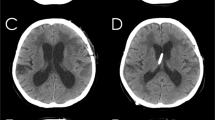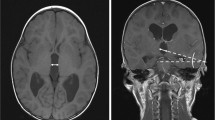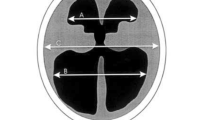Summary
Thirty-one hydrocephalic patients were investigated prospectively by means of computed tomographic scan performed prior to and one week after cerebrospinal fluid (CSF) shunting. Planimetric measurements of the size of the cerebral ventricles were compared before and after shunting. Children under two years of age and elderly patients showed significantly less reduction of ventricular size (8.5±6.3% and 9.7±3.5% respectively) than older children and young adults (61.2±5.2%). The degree of reduction of ventricular size did not correlate with pre-operative size of ventricles, duration of disease, or clinical improvement.
These findings suggest that reduction of ventricular size following CSF shunting is related to age. We postulate that the size of cerebral ventricles in hydrocephalic patients is not exclusively related to CSF dynamics, but also depends upon the intrinsic elastic properties of the cerebral parenchyma which vary with age.
Similar content being viewed by others
References
Cardoso ER, Del Bigio MR, Schroeder G (1989) Age-dependent changes of cerebral ventricular size. Part I: Review of intracranial fluid collections. Acta Neurochir (Wien) 97: 130–136
Faulhauer K, Schmitz P (1978) Overdrainage phenomena in shunt treated hydrocephalus. Acta Neurochir (Wien) 45: 89–101
Gruber R (1983) Should “normalization” of the ventricles be the goal of hydrocephalus therapy. Z Kinderchir 38 [Suppl II]: 80–83
Gruber R, Jenny P, Herzog B (1984) Experiences with the antisiphon device (ASD) in shunt therapy of pediatric hydrocephalus. J Neurosurg 61: 156–162
Horbar JD, Walters CL, Philip AGS, Lucey JF (1980) Ultrasound detection of changing ventricular size in post-hemorrhagic hydrocephalus. Pediatrics 66: 674–678
Hyde-Rowan MD, Rekate HL, Nulsen FE (1982) Re-expansion of previously collapsed ventricles: The slit ventricle syndrome. J Neurosurg 56: 536–539
Johnston IH, Howman-Giles R, Whittle IR (1984) The arrest of treated hydrocephalus in children: A radionuclide study. J Neurosurg 61: 752–756
Kaufman B, Weiss MH, Young HF, Nulsen FE (1973) Effects of prolonged cerebrospinal fluid shunting on skull and brain. J Neurosurg 38: 729–738
Linder M, Diehl JT, Sklar FH (1981) Significance of post-shunt ventricular asymmetries. J Neurosurg 55: 183–186
Milhorat TH (1987) Hydrocephaly. In: Myrianthopoulos NC (ed) Handbook of clinical neurology, vol 6 (50) Malformations. Elsevier, Amsterdam, pp 285–300
Rubin RC, Hochwald G, Tiell M, Liwnicz B, Epstein F (1975) Reconstitution of cerebral cortical mantle in shunt corrected hydrocephalus. Dev Med Child Neurol 17 [Suppl] 35: 151–156
Samarajski T, Rolsten C (1973) Age and regional differences in the chemical composition of brains of mice, monkeys and humans. In: Ford DH (ed) Neurobiological aspects of maturation and aging. Elsevier Scientific Prog Brain Res 40: 253–265
Shenkin HA, Greenberg JO, Grossman CB (1975) Ventricular size after shunting for idiopathic normal pressure hydrocephalus. J Neurol Neurosurg Psychiatry 38: 833–837
Synek V, Reuben JR (1976) The ventricular brain ratio using planimetric measurements of EMI scans. Br J Radiol 49: 233–237
Tans JTJ, Poortvliet DCJ (1988) Reduction of ventricle size after shunting for normal pressure hydrocephalus related to CSF dynamics before shunting. J Neurol Neurosurg Psychiatry 51: 521–525
Terry RD, DeTeresa R, Hansen LA (1987) Neocortical cell counts in normal human adult aging. Ann Neurol 21: 530–539
West KA (1970) On pre- and post-operative head growth and cerebral ventricular size in hydrocephalic infants and children. Neuropediatrie 2: 206–214
Author information
Authors and Affiliations
Rights and permissions
About this article
Cite this article
Cardoso, E.R., Del Bigio, M.R. Age-related changes of cerebral ventricular size. Acta neurochir 97, 135–138 (1989). https://doi.org/10.1007/BF01772825
Issue Date:
DOI: https://doi.org/10.1007/BF01772825




